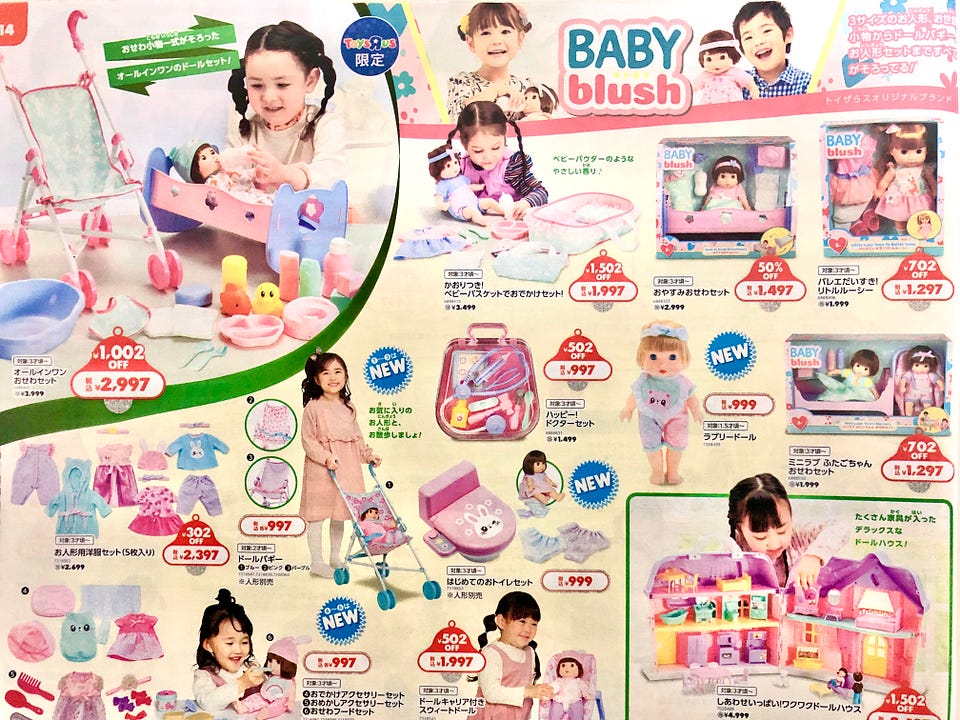[ad_1]
“He’s a boy but he likes Frozen and Elsa!” My 5-year-old daughter exclaimed the other day, catching me off guard. It was shocking because I prided myself on selecting just the right school.
Her all-English kindergarten in Tokyo had been understanding of children from various backgrounds, never asking me to let her wear a skirt. Keeping her environment gender-neutral was my secret mission.
When I tried to think of ways to help promote balance I recalled a headline I’d read. According to a survey, Japanese girls start believing they’re nicer than boys at age 4, while boys think they’re smarter than girls by the time they become 7.
In the study, more than 70% of girls replied kindness is a women’s trait[1].
Rikejo: The gendered label only female students are called
Japan ranked 116th among 146 countries in the World Economic Forum’s gender gap report in 2022. Some point out that Japan earns high equality marks up until high school because of equal primary and secondary education availability.
However, this doesn’t necessarily mean female students don’t struggle with gender stereotypes.
Last summer, 4 high school students uploaded a series of 5 YouTube videos in which they recreated scenes from their experience of dealing with the gender stereotypes that they regularly encounter at school. One video portrayed a teacher’s dismissal of a female student who wishes to be an engineer. Listening to the student’s hope to choose science-focused classes, her teacher says, “When it comes to girls, they usually choose humanities,” and, “Is ‘rikejo (リケジョ)’ trending? That’s an unusual choice.”
Rikejo is an abbreviation for rikei-joshi (理系女子), which means women who seek careers in science. Although some women use this term voluntarily, it is undeniable that the word connotes a mocking nuance. And there’s no word in the lexicon that corresponds to men in the science field.
In this video, the student asks her teacher why only girls are called “rikejo” if they go into science. She demands her teacher should stop calling her rikejo because she’s serious about her dream just like male students. The message has sparked intense debate on social media and has been widely reported on by Japanese mainstream media outlets.
Japan has the lowest share of women in STEM fields
This brilliance bias that only boys can be really smart significantly limits girls’ possibilities. Japan has the lowest proportion of women in STEM (science, technology, engineering, and mathematics) fields among 36 OECD countries[2].
The most noticeable gap with other countries is the women’s self-imposed mental barrier. As reported by American conglomerate 3M, 42% of Japanese women answered they thought they were not smart enough to seek STEM, compared to the global average of 25%[3].
Taking these study results into account, Japan shouldn’t jump to the conclusion that there are no gender gaps among children. Rather, Japanese children are constantly being unfairly divided into two opposing gender identities by both traditional and modern customs.
Girls celebrate marriage from newborn
When couples have a child in Japan, there are a few additional things on their to-do list. One of the most common practices is to buy either a set of Hina dolls (雛人形) or a Satsuki doll (五月人形). This is the first in the lead-up to holding separate festivals for children in Japan: Girls celebrating on March 3 and the second day observed for boys on May 5, excluding consideration of other gender orientations.
More than 91% of new parents with girls celebrate their first Doll Festival (hina-matsuri, 雛祭り) on March 3. 94% of them decorate Hina dolls for their daughters[4]. However, the traditional festival for girls is really the first step down the aisle. Instead of encouraging girls to become independent, Hina dolls are staged in doll marriage ceremonies.
The dolls’ models are the emperor and empress, which are often accompanied by supplemental dolls of ministers and maids. Many parents hold the superstitious belief that if they don’t put away the dolls promptly after March 3, it will hurt their daughter’s chances of getting married in the ‘marriageable’ age range. (This theory is groundless.)[5].
The implication that the successful path is to get married to a powerful man bothers me so much that I haven’t purchased traditional dolls for my daughter, except for wooden blocks of Disney characters in kimono. Minny Mouse is also forever stuck in second place. But blocks give more of a sense of flexibility than traditional Hina dolls, which imply marriage is a must for women’s lives.
Boys admire samurai armor and wish for successful careers
Meanwhile, boys’ parents celebrate Boy’s Festival on May 5. It’s also a public holiday known as Children’s Day, yet boys are the protagonists. The boys in armor are typically modeled after the local famous samurai warriors. Unlike the festival for girls, which features both the bride and groom, there is no room for female dolls on small samurai day.
The carp streamer koi-nobori (鯉のぼり) is another symbol of Children’s Day. Since carp (koi) can swim upstream, boys’ parents fly carp streamers in the hope that their descendants will grow up healthy and successful. It has become common to fly this streamer irrespective of children’s gender, but the connection with boys still remains even today.
Boys first, Girls next traditions
Another classic custom that plays favorites with boys is Shichi-Go-San (七五三), which is celebrated around November 15. The origin of this ceremony dates back over 1200 years when child mortality was high due to the lack of adequate medical treatment. People called kids ‘the god’s children’ until they turn 7, and celebrated when children were at 3, 5, and 7.
To this day, both boys and girls celebrate 3 years old with the child version of casual kimono, although some boys’ parents skip this age. At age 5, only boys wear their first proper hakama (袴), an old form of men’s formal wear. Girls should wait two more years to wear their first complete kimono with obi belts. Boys used to join society as men faster, leaving girls behind.
It remains a mystery as to why girls should wait two years longer than boys to celebrate wearing formal attire. But these long-lasting festivals and ceremonies are hard to reshape. Most parents follow in their ancestors’ footsteps without second guessing.
Who shuts girls out of STEM careers first?
Experts in the UK claim that children fully form their attitudes toward gender by the age of 7[6]. The author of “Invisible Women,” Caroline Criado Perez also points out that 6-year-old girls suddenly start limiting themselves and stop choosing toys that are designed for ‘really smart children,’ as indicated by a recent study in the US.
Given these facts and Japanese patriarchal traditions, parents and teachers should be aware that their cheerleading goes a long way. That’s because children in this age band tend to be sticklers for rules.
Event organizers in STEM often explain male dominance by claiming that there happen to be no women in the field. However, in reality, Tokyo Medical University rigged its entrance exams to accept more male students in 2018. They favored men with the desire for preventing a shortage of doctors believing that female doctors resign after their marriage or deliveries.
Although this elimination of women is an extreme case, it is irrefutable that adults encourage girls to dream more about their future marriage and motherhood than becoming scientists or professors. In the Christmas catalog issued by Toys ‘R’ Us Japan, gender bias was in full swing. I wouldn’t nitpick the number of boy/girl models in each section, but the insinuation of old gender stereotypes that women should take parenthood more seriously than men was palpable.

Toy stores in Japan still tell children what to play with gender filters
Toys ‘R’ Us Japan started replacing ‘Toys for boys/girls’ signs with gender-neutral signs in 2021[7]. Perhaps because many toy stores in Western countries had already stopped these gendered signs in the 2010s. However, the change has been coming at a glacial pace. Toys ‘R’ Us Japan sold its lucky bags—better known as fuku-bukuro (福袋)—with binary tags ‘for boys/girls’ until now.
Unfortunately, it is not difficult to find signs like 男児おもちゃ (Toys for boys) and 女児おもちゃ (Toys for girls) in Japan. Typically, radio-controlled toys and superhero toys are sub-categorized under ‘For boys’ signs while kitchen toys and jewelry-making kits target girls.
Gendered labels deprive children of freedom and creativity
You might think that categorizing toys in this way is helpful for gift-givers, especially grandparents who have no idea what their grandchildren are into. However, biased descriptions foster children’s unconscious bias.
Let’s say a 4-year-old girl receives a glittery dressing table from her grandparents only because she is a girl. Do you think she can say, “Grandpa, I want a cool dinosaur toy. Could you please return this?” If the aforementioned study is accurate, she may already be developing the belief that girls should be nice. She is more likely to keep the gift and think that looking into the mirror is the right thing to do.
Director & Representative Executive Officer of toy manufacturer People, Masato Kiribuchi, says he still remembers well how his son took care of a baby doll at age 2, then secretly played with it at 3, and completely stopped using it at 5[8].
Children take people’s remarks to heart. The toy production company LEGO reports that 71% of boys and 42% of girls are afraid of being made fun of in case they play with a toy designed for the other gender[9].

Customs are changing, and so should we
In 2019, Japanese toy maker BANDAI released a new line of boy baby dolls named ‘horun (ホルン)’ in anticipation of potential demand. Baby dolls in Japan had been overwhelmingly baby girls, which targeted female infants as young as 1.5 years old. The previously cited company People also launched a DIY toy designed for girls in 2018. Japan’s toy market has finally become a little more inclusive, even though Toys ‘R’ Us Japan has yet to reflect these changes in its advertising.
I’m also no stranger to gender bias. When I bought a toy car for my daughter a couple of years ago, my husband asked me, “For our girl?” and tilted his head. I replied, “Why not? She wanted it.” Although she quickly lost interest in the car and stopped playing with it, the following Christmas she requested a toy helicopter. This time nobody around her—including her grandparents—objected to her idea, and she happily received the gray and pink helicopter with Paw Patrol characters.
My daughter still surprises me when she says “I should wear a skirt” out of the blue. I’m hoping the response I usually give—”only if you really like it”—helps us become better human beings.
What to read next
Why Feminism Remains “The F-Word” in Japan
Sources
[1] Japanese children develop subconscious gender biases at young age, study shows The Japan Times
[2] Japan has lowest share of women studying science: OECD report Kyodo News+
[3] 「STEM目指す女子への偏見ない」日本が世界1位。現実とギャップ Business Insider
[4] もうすぐひな祭り!女の子がいる家庭へ「初節句」に関する実態調査を実施。PR Times
[5] 雛人形の片づけは「ゆっくりでOK」嫁に行き遅れる説の由来 中日新聞
[6] Gender stereotypes in childhood: what’s the harm? Birmingham City School of Education and Social Work
[7] 売り場、性別関係なく トイザらスはおもちゃ棚を融合 日本経済新聞
[8] 大好きなお人形で遊べなくなった男の子に「選ぶ自由」を。老舗おもちゃメーカー代表の挑戦 Huffpost
[9] Girls are ready to overcome gender norms but society continues to enforce biases that hamper their creative potential LEGO
https://unseenjapan.com/media/a89a58e1e57371909ac257b2d42ea48b
[ad_2]
Source link


